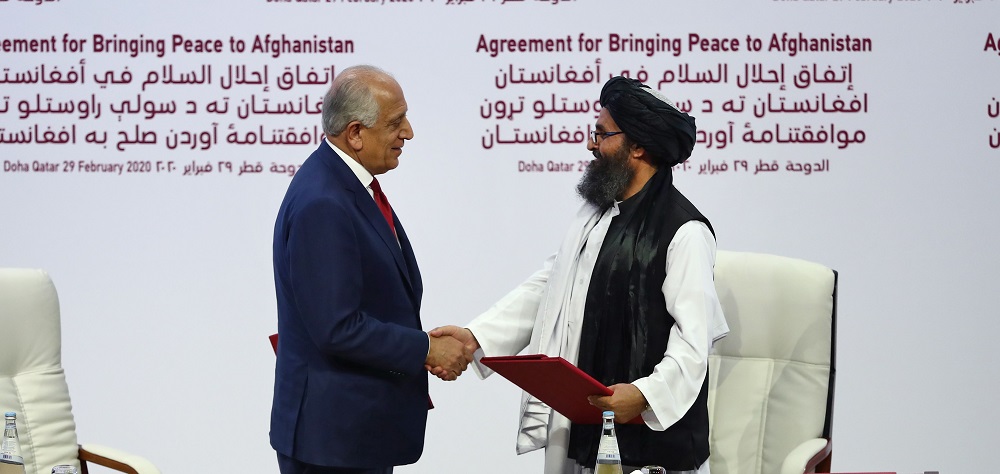Alwaght- Foretelling the fate of the US-Taliban agreement is not that difficult these days. During the past two months of the deal between Washington and the militant group, the two sides have exchanged accusations, making the Doha agreement every day more delicate than the day before. Generally, it seems that the agreement has two fundamental problems adding to its fragility.
Three parties, bilateral agreement
First of all, the parties engaged in the negotiations to secure peace for future Afghanistan in practice are three: The US, Kabul government, and the Taliban. But the peace deal was bilateral, signed between the Americans and the insurgent group.
The Kabul government did not sign the accord but it is an implementation party to it. This makes the government to tie implementation of the terms to realization of the demands it in the past made during the bilateral talks with the Taliban representatives.
On the other side, the Taliban expects the government to implement the commitments given in the text of the deal signed by the US envoy Zalmay Khalilzad. Odds are Washington on the Kabul behalf made commitments that are not much acceptable by the Afghan government.
So, the essential flaw of the deal is the lack of the signature of the third party that transforms the optimism about a peaceful future to pessimism.
Trilateral pessimism, the Achilles heel of the bilateral agreement
The absence of the signature of the government in the agreement has a significant outcome to communicate: The three sides have not had a shared understanding of the peace in Afghanistan.
To put it differently, all the three parties of interest in the deal each have their own interpretation that is different from the others. This gives rise to a trilateral pessimism and the resultant discontent of the three sides.
The Taliban: The militant group is not satisfied with less than the exit of the foreign and American forces from Afghanistan and seizing the full political power in Kabul. The Taliban said that it believes in a power-sharing government process with Kabul but its definition of the power-sharing government is fundamentally different from what other Afghan groups have in mind.
Furthermore, the group is highly pessimistic about the Kabul government and sees it as an outcome of agreement of foreign powers. It has so far failed to recognize the presidential elections in the country, including the one held last year that brought to power again President Ashraf Ghani. It does not spare any chance to voice its thought that the government in Arg Palace is illegitimate. It seems that the election model eyed by the group includes a Taliban-supervised and executed election and even reserving the right to introduce a vetting regime for the qualification of the candidates. Otherwise, it labels the election process illegitimate.
Kabul government: The government in Kabul is seriously doubtful to agree to the Taliban participation in the power structure as it fears the group’s spirit of power monopolization. In case of power seizure by the Taliban, the process of yet unfinished government-building that has been underway for the past 19 years will stop or derail from its main course.
Actually, the officials of the Arg Palace do not grow much hope about holding the power in their hands as they do not under a deal in which the Taliban participate in the political process. They are afraid that the group will seize the power from the streets of Kabul using force.
The US: The US on the one hand is unrealistically optimistic and on the other hand is pessimistic about both the Kabul government and the Taliban. Washington as the main side of the peace accord has developed dissatisfaction with the Kabul approach to the agreement and even worse finds the government an obstacle ahead of the implementation process. It demands Kabul to fully comply with the terms of a deal it never signed or was not party to.
In other words, the interventionist American gesture in the Afghanistan developments and the White House expectation of the Kabul government to precisely implement the terms of the February 29 agreement do not comply with the central government’s sovereignty and independence. In fact, Washington has a high-position approach to the Kabul that not only questions the government’s independence of action but also in practice further weakens the administration in Kabul as it is pressed to implement an agreement Washington, not Kabul, is a party to.
Washington is quite hopeful about the success of the deal, anticipating the Taliban to step in the country’s current political structure as a political party after the deal. Washington wants the group to recognize other groups and join the elections as a civilian and unarmed party.
This excessive optimism of the Washington officials stems from the fact that the White House has so far failed, or did not want, to figure out the reasons driving the Taliban to oppose the Kabul political process. While the group fundamentally sees the Kabul government illegal, Washington hopes to see it join the civilian competitions, while such expectation is way far from the country’s realities.



























